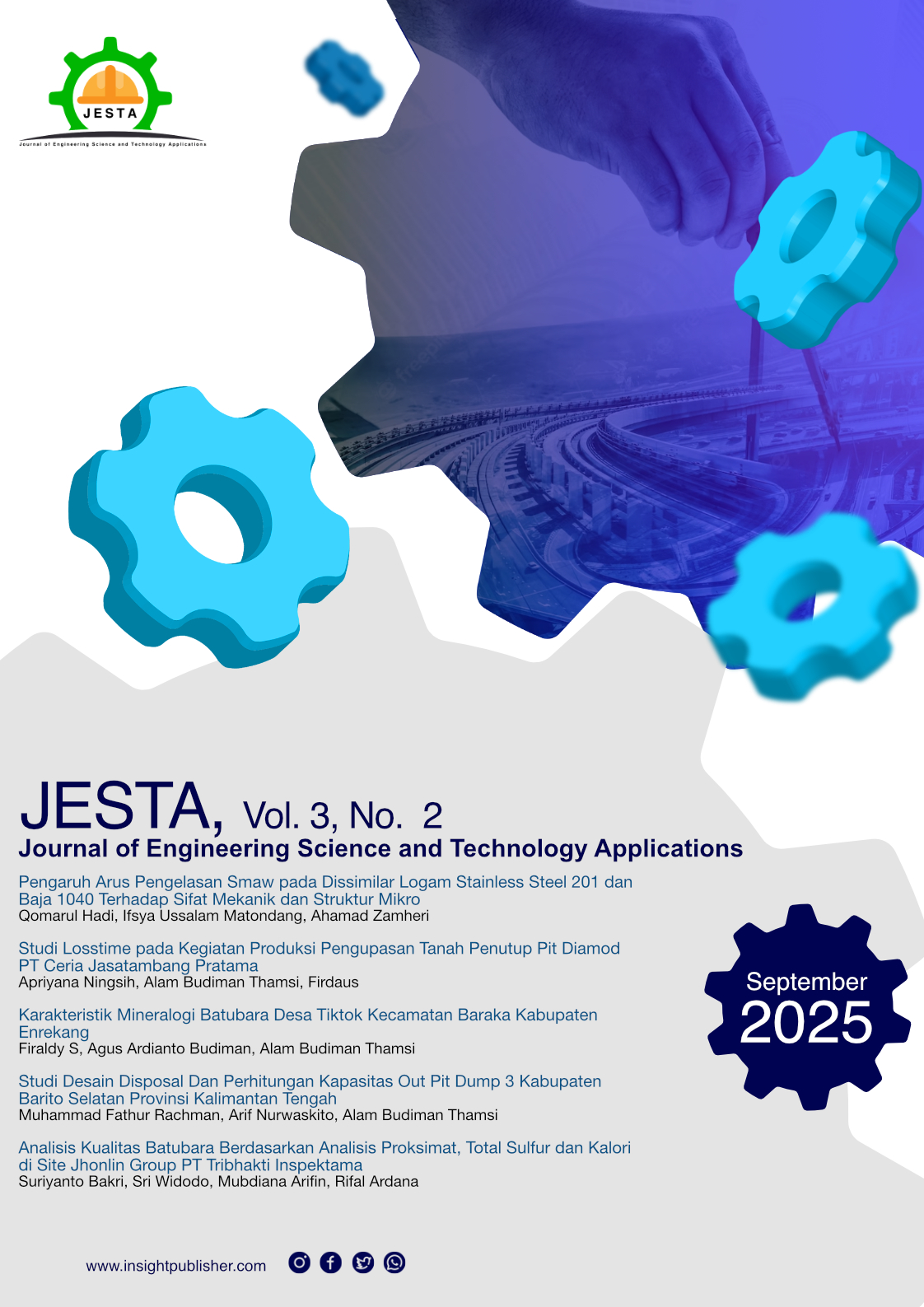Studi Losstime pada Kegiatan Produksi Pengupasan Tanah Penutup Pit Diamod PT Ceria Jasatambang Pratama
Study Of Lost Time in the Production Activities of Cover Soil Stripping at The Diamod Pit of PT Ceria Jasatambang Pratama
DOI:
https://doi.org/10.58227/jesta.v3i2.296Keywords:
Losstime, Work Efficiency, Productivity, Overburden, Cycle TimeAbstract
PT Ceria Nugraha Indotama, precisely in the diamond pit managed by the contractor PT Ceria Jasatambang Pratama, there are 2 overburden stripping fleets, based on the production target data for March 2025, fleet 1 is 7,731 Bcm and fleet 2 is 3,257 Bcm with actual production of fleet 1 being 4,243.29 Bcm and fleet 2 being 5,365.00 Bcm. This research aims to find out the value and what are the losstime components of the load excavation tool in the overburden soil stripping activity at pit diamond 01 and pit diamond 02 of PT Ceria Jasatambang Pratama in March 2025. This activity is very important to support the smoothness of the nickel ore mining process. The research was conducted with field observation methods as well as primary and secondary data processing using microsoft excel software. The results of the study showed that the actual loss of time that was identified came from five main components, namely: rain and slippery roads (slippery), late starting work early shifts, breaks that started too early, delays in returning to work after a break and stopping work too early. Total losstime for one month in fleet 1 was recorded as 65 hours (average 2,2 hours per month), while fleet 2 was 60 hours (average 2,00 hours per month). This value shows that most of the effective working time is wasted due to these obstacles. The actual productivity of each fleet is calculated based on work efficiency, cycle time, swell factor and fill factor. Fleet 1 produces productivity of 812,25 tons/day and fleet 2 of 1,410,05 tons/day. This result shows the non-achieval of the production target in fleet 1, which is caused by the difference in bucket capacity on the loading and unloading equipment and the high loss time value. Suggested loss time reduction efforts include improving work discipline, implementation of P5M activities (five-minute talk), daily inspection (P2H), and regulation of refueling and slippery activities. This research is expected to be the basis for decision making in improving the operational efficiency of overburden mining. The average monthly value for fleet 1 was 2.2 hours with the losstime component being influenced by taking breaks too early, while for fleet 2 it was 2.00 hours, with the most influential losstime component consisting of starting late after a break.
References
Anisari, R. (2016). Produktivitas Alat Muat Dan Angkut Pada Pengupasan Lapisan Tanah Penutup Di Pit 8 Fleet D PT . Jhonlin Baratama Jobsite Satui Kalimantan Selatan. Intekna, 16(1), 77–81.
Beno, J., Silen, A. ., & Yanti, M. (2022). Analisis Keserasian Alat Gali Muat dan Angkut Terhadap Produktivitas pada Pengupasan Overburden pada Tambang Batubara dan Nikel. Braz Dent J., 33(1), 1–12.
Fajar, U. (2021). Studi produktivitas kerja dan waktu penggunaan alat berat.
Geomine, J. (2017). Biaya Penambangan Nikel Pada Pt . Bintang Delapan Mineral. 5(2), 76–79.
Hartono, H., & Fatkhurozi, F. (2021). Penerapan Kaizen Untuk Mengurangi Loss Time Dalam Peningkatan Produktivitas Mesin Infrared Welding (Studi Kasus Pt. Mitsuba Indonesia). Journal Industrial Manufacturing, 6(1), 01. https://doi.org/10.31000/jim.v6i1.4114.
Hibatullah, F., Syahrudin, ), & Setiawati, S. (2023). Kajian Produktivitas Alatiigali Muatiidan Alat Angkutdalam Peningkatan Produksi pada penambangan Batugranit Di Pt. Strada Multiperkasa Kecamatan Sajingan besar Kabupaten Sambas Kalimantan Barat. 1–10.
Ilmiah, J., Batanghari, U., & Vol, J. (2015). 225618-Efisiensi-Penggunaan-Alat-Berat-Pada-Pek-E4a5B318. 15(3), 90–95.
Josua Nolam Analiser. (2023). Optimalisasi Ketercapaian Produksi Alat Gali Muat dan Alat Angkut Pada Pengupasan Overburden di CV. Bunda Kandung Desa Lemo Kecamatan Taweh Tengah Kabupaten Barito Utara Provinsi Kalimantan Tengah. Teknologi Informasi Dan Industri, 3(1), 92–98.
Kebumian, J. T., Hakim, M. El, & Wiratama, J. (2022). Hakim dkk (2022). 08, 55–62.
Khair, A., Triantoro, A., Riswan, R., & Hidayat, W. N. (2019). Evaluasi Pencapaian Target Produktivitas Alat Gali Muat Dan Alat Angkut Pada Aktivitas Pemindahan Overburden Di Pit1 Blok15 Pt Rimau Energy Mining, Site Putut Tawuluh. Jurnal Himasapta, 4(01), 17–24. https://doi.org/10.20527/jhs.v4i01.474.
Muis, A. R. (2007). Operator Alat Berat Wheel Loader. TeknikA, 1(28), 98–101.
Rika Widianita, D. (2023). Efisiensi Penggunaan Alat Berat Pada Pekerjaan Pembangunan Tpa (Tempat Pemprosesan Akhir ) Desa Amd Kec. Muara. In At-Tawassuth: Jurnal Ekonomi Islam: Vol. VIII (Issue I).
Rina Amelia, Slamet Triyadi, U. M. (2023). 3 1,2,3. Jurnal Ilmiah Wahana Pendidikan, 9(23), 656–664.
Tri, P. T., & Sarimas, B. (2021). Penentuan Nilai Keserasian (Match Factor) Untuk Optimalisasi Alat Berat Pada Pekerjaan Pemindahan Tanah Penutup Pertambangan Batubara Pt Tri Bakti Sarimas.. 4(1), 480–491.
Wardana, R. F., Tono, E. P. S. B. T., & Andini, D. E. (2021). Kajian Efektifitas Kerja Operator dan Kondisi Alat pada Front Penambangan Tambang Besar Pemali PT Timah Tbk. Mineral, 6(1), 25–30. https://doi.org/10.33019/mineral.v6i1.3082
Downloads
Published
Issue
Section
License
Copyright (c) 2025 Journal of Engineering Science and Technology Applications

This work is licensed under a Creative Commons Attribution-ShareAlike 4.0 International License.








